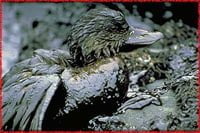On 23rd March 1989 the oil tanker Exxon Valdez left normal shipping lanes and smashed into the Bligh Reef in Prince William Sound, Alaska. Within hours, the once mighty vessel had spilled over ten million gallons of oil into the icy waters: the largest oil spill in ever recorded in US waters.
Over the coming months, around eleven thousand square miles of open sea became contaminated. Local wildlife – many species of which were rare or endangered elsewhere – perished in vast quantities. News reports brought back footage of over 1,300 miles of shoreline turned black and scattered with dead or dying fish, birds, and seals.
As the company responsible, Exxon Mobile was slow to act. In the first few days of the spill efforts to contain its effects were primarily carried out by local people with buckets and hoses.
The professional cleanup did not begin until April; although once the operation was underway it involved over ten thousand personnel, fifteen hundred vessels and 85 aircraft.
It was not until 1992 – three years later – however that the coastguard and Exxon declared the operation a success.
Such a ‘success’ has been marred by the fact that no contingency plan existed for a spill of such size. Disaster crews were often inexperienced, which resulted in setbacks such as the sinking of special booms set up to contain the spread of surface oil.
Funding was also scarce, and Exxon’s initial reluctance to engage in an extensive clean up was coupled with an unwillingness to provide hard cash. In desperation, the Federal Government brought in the US army’s Corp of Engineers to provide assistance, who soon butted heads with both Exxon and the coast guard.
The damage howeer had already been done. Sizeable sections of coastline were devastated, with financial losses in terms of tourism alone caculated at $2.8 billion. The fishing industry was decimated, leading to coastal communities suffering the effects of job losses alongside the calamity of environmental destruction.
To the present day, the area has not fully recovered. Whereas oil on the surface of sand and earth was easily dealt with, that which permeated deeper into the coastline is more problematic. Studies have revealed evidence of oil lingering on in the lower inter-tidal zone – traditionally the home of mussels, clams and other marine life.
This continues to have a negative impact on species reliant on such creatures for food, which in turn is disrupting the local ecosystem.
The once abundant herring population is one such group that has failed to return to pre-spill levels. This has affected the area economically as herring fishing once provided substantial revenue for small businesses and larger commercial enterprises alike.
This has also meant added hardship for “subsistence” harvesting, as in communities that have depended on the ocean directly for generations. Native Alaskans have thus had both their culture and livelihood infringed upon, as much of the traditional methods of fishing and foraging yield nothing but contaminated produce.
Originally the Exxon Valdez departed from established shipping lanes in hope of avoiding the ice in the waters around the Trans Alaska Pipeline terminal.
Those on duty had orders from the captain to steer the ship back onto its planned course once the ice floes had been cleared. For undisclosed reasons this did not happen, although it is known that the crewmen were suffering from fatigue at the time of starting their shift.
An investigation summarised five reasons behind the pilot error, two of them involving human fatigue, another intoxication, another down to simple negligence and the fifth due to a possible lack of effecient navigation systems.
The disaster highlighted more than a few concerns in corporate running of oil tankers. A coast guard study at the time revealed that in eight out of ten accidents human error was the cause, usually because of exhastion.
Tankers were also shockingly understaffed, with some crews enduring a 90 hour work weeks with sleep caught in four hour patches. At the time of the spill the Exxon Valdez had just 19 crewmen to transport its 53 million gallons of oil in a vessel almost a thousand feet long.
In the 1950s, vessels transporting as little as six million gallons could expect a crew complement of forty plus. Crew numbers had been run down in order to save Exxon money. This ‘economy’ caused a terrible cost to the livelihoods of many thousands and to the environment.
The spill sent shockwaves through both the environmental and cooperate worlds, which have led to a series of reforms aimed at avoiding similar disasters.
Tankers are now outfitted with double-layers hulls and escort tugs under the Oil Pollution Act of 1990.
Under the Act, the owner of a vessel from which oil is spilled is also liable to financially support any clean up effort. If such a party is unable or unwilling to pay however, monies are taken from the Oil Spill Liability Trust Fund, which gains revenue via a tax on each barrel of oil imported into the US.
In 1991 the US district court passed a civil settlement obtaining $900 million from Exxon to be paid to the Federal Government and the State of Alaska.
Since then however the Supreme Court has annulled the fine and instituted a new pending amount of just $500 million – still not paid.
Exxon has thus profited in the years preceding the disaster by routinely running understaffed and poorly equipped tankers. Disaster response teams were also inadequately outfitted, which played a part in the spill turning into such an unmitigated catastrophe.
The oil that lingers on just a few feet under the beaches and sea bed continues to affect marine life, native Alaskans and the livelihoods of fishermen alike.
In that sense, the Exxon Valdez spill, a calamity caused by corporate malpractice, is still not over.





